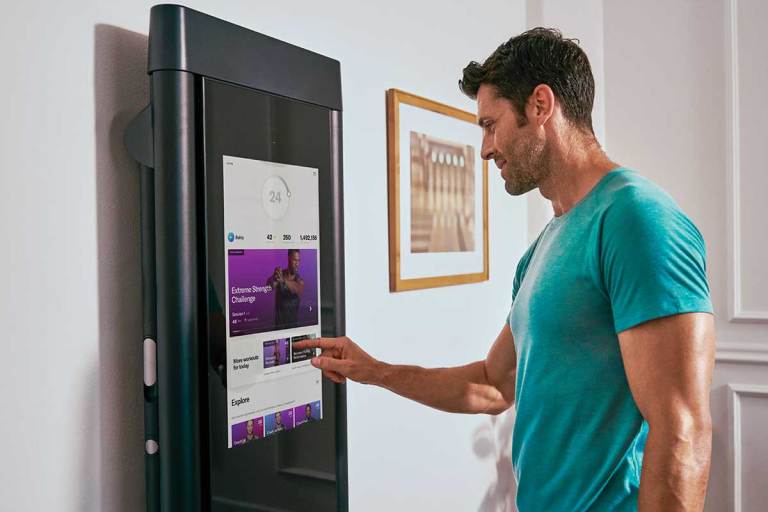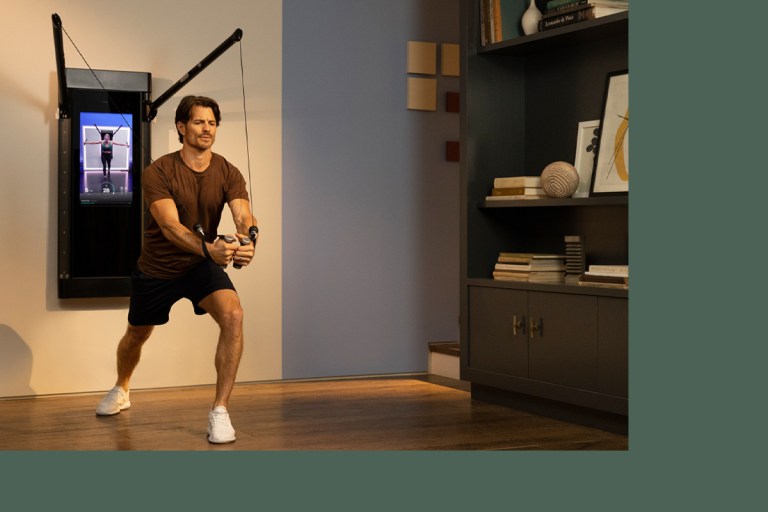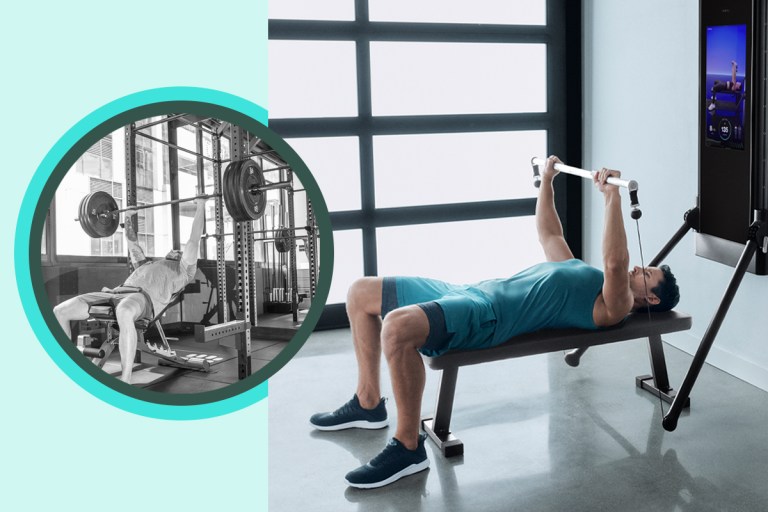How Periodization Training Can Help You Hit Your Fitness Goals Faster
Break up your training into discrete phases to achieve success and avoid plateaus.

A lofty goal, whether it’s running your first half-marathon or getting in shape for your wedding, can feel intimidating when the big day is months away, and you’ve yet to get started. Breaking your training down into smaller, manageable chunks can help you stay motivated, assess your progress along the way, and adjust as needed. Periodization training is a proven strategy to organize your long-term plan into distinct phases (also referred to as cycles or blocks), each with its own mini-goal.
“It’s a strategic way of looking at how all of your workouts tie together to a larger goal,” says Tonal coach and certified personal trainer Joe Rodonis. “It allows you to be focused on a goal throughout the year while also allowing for manipulation of things like rest, intensity, and exercise selection. They all work together to drive an adaptation.”
Periodization training can help you avoid boredom and break through plateaus by mixing up your workout stimulus while still keeping you on track to reach your end goal.
What is Periodization for Strength Training?
Periodization refers to planned, cyclic changes in training stimuli to drive specific adaptations such as increases in strength, power, endurance, or changes in body composition.
While periodization is typically utilized to train athletes seeking to achieve peak performance for a specific competition, it can also be useful for those just looking to improve their overall fitness or reach a goal within a set timeline.
To see how these phases fit into your larger plan, it’s helpful to divide your training into three cycles. From longest to shortest, these are known as macrocycles, mesocycles, and microcycles:
- Macrocycle: Anywhere from several months to multiple years in length, typically centered on a single goal such as a physique competition, a marathon or looking strong and feeling confident for an event like a wedding or vacation.
- Mesocycle: Typically one to three months long, with each mesocycle focused on one element of your larger goal. In the running example, this could be a cycle of endurance training followed by a cycle of speedwork. If you’re prepping for your wedding, you might spend a month concentrating on building muscle followed by a month devoted to getting lean.
- Microcyle: Usually one to two weeks in length. Individual workouts are slotted into each microcycle.

Each period of training can be distinguished by changing variables such as exercise selection, training frequency, number of reps and sets, intensity of resistance (or what percentage of your one-rep max you’re lifting), or rest between sets. By manipulating these variables, you can drive multiple adaptations that all build toward your broader goal.
The principle of progressive overload, or the gradual increase of stress over time to stimulate adaptations, will apply to each training phase although the type of stress you’re working with will differ. A strength cycle, for example, would include gradually increasing resistance while an endurance cycle would involve increasing the duration of your working sets.
Periodization is personal. It’s good to have a plan, and for that plan to be flexible. There’s no one singular path to get you to your goal.
– John Christie, CSCS, RD, and Tonal Director of Curriculum
Switching up your workouts helps avoid overtraining or finding diminishing returns in one particular adaptation. “If you focus on any one thing for a long period of time, longer than roughly 12 weeks, your returns start to diminish,” says John Christie, CSCS, RD, and Tonal Director of Curriculum. “As you make fewer and smaller adaptations over time, take this as a signal that you could benefit from shifting to a different focus toward new training stimulus and different changes in the body.” Additionally, the gains you make in one cycle can contribute to raising your potential in the next.
While there are multiple different ways you can periodize your training, you don’t need to include every possible phase. “Periodization is personal,” says Christie. “It’s good to have a plan, and for that plan to be flexible. There’s no one singular path to get you to your goal.” The phases and order in which you complete them will depend on your own goals and your timeline. Here are some of the phases you can choose from in constructing your training cycle:
General Preparation
This training phase emphasizes functional movement and movement quality, which could include form drills as well as exercises to improve balance, stability, and coordination. This is usually the first training phase an athlete will do once returning to action after an off-season. It’s also beneficial to people who are new to strength training or want to work on lifting form.
“It’s not really about intensity,” says Rodonis, “you’re just getting used to a specific skill set.” For an athlete, this might be followed by a sport-specific preparation phase where you work on developing strength and power in the movements you’ll do in competition, such as throwing a baseball or swinging a tennis racket.
Sample Tonal Programs: Strength Training 101, Pre-Season Performance
Hypertrophy
When you’re training for hypertrophy or building muscle mass, your aim is to rack up lots of volume and time under tension, which is why this phase is also called accumulation. Compared to a max strength training cycle, you’ll be doing higher rep sets and performing more sets per week when you’re working on gaining lean muscle mass.
Sample Tonal Programs: House of Volume, Extreme Accumulation
Strength
For maximizing strength gains, you’ll move from higher-rep, lower-weight to lower-rep, higher-weight sets during the course of a training cycle. At first, “you’re thinking more about your form and less about the weight,” according to Rodonis, “and then as the weeks progress, you can start to decrease the amount of repetitions and increase the intensity of the weight.” By the end of a strength cycle, you could be doing as few as 3 to 5 reps of an exercise with a weight that’s a high percentage of your one-rep max. This type of training is also known as intensification. Rodonis says one type of periodized training is simply alternating between accumulation and intensification phases monthly.
Sample Tonal Programs: Absolute Strength, 20-in-20: The Functional 5
Work Capacity
If your goal is getting lean and burning fat, you’ll benefit from including a cycle of work capacity-focused training. This type of training works well when done after a hypertrophy cycle so you can build lean muscle and burn fat to shift overall body composition. During this training phase, you’ll typically incorporate high-intensity resistance training or metabolic conditioning. These demanding, high-density workouts elevate your heart rate to burn more calories both during your lifting session and when you’re at rest.
Sample Tonal Programs: 20-in-20: Metabolic Burn, 20-in-20: Fire Circuits
Recovery/Deload
After a period of heavy training, a few weeks of active recovery or deloading can ease tired muscles and prep them for your next training phase. In these workouts, you’ll drop the amount of weight you’re lifting or even just use bodyweight moves to maintain mobility and promote circulation and healing. If you’re training for a race or major competition, you might do a short deload before your event so your muscles aren’t fatigued when you need to perform, and then add another recovery cycle after the competition to start your rebuilding.
Sample Tonal Workouts: Deep Stretch and Deload, Mobilize and Stabilize, or try any workout with Recovery Weights activated.
How to Structure Your Periodization Training
The simplest and most common type of periodized training is linear periodization, in which you only focus on increasing one variable (for example, resistance or reps) at a time. Rodonis says linear periodization is great for beginner and intermediate lifters who can make big gains with small increases in stress.
More advanced exercisers have the option of experimenting with undulating periodization, which involves switching up your training types within a mesocycle or even a microcycle to develop multiple adaptations concurrently. That could look like doing one max strength workout, one hypertrophy workout, and one muscular endurance session within a single week. Undulating periodization is generally recommended for advanced lifters, according to Rodonis. “Over time, the body adapts,” he says, explaining that if you’ve been training for years linear periodization can start to feel predictable and won’t result in as robust improvements.
One popular style of undulating periodization is the conjugate method that blends high-weight, low-speed lifts with lighter-weight, high-speed reps within the same week to build both strength and power. You’ll find the conjugate method in Tonal programs such as Power Build and Off-Season Strength.
The Bottom Line
Periodization seems complex—and for high-level athletes looking to fine-tune the smallest details of their training it can be complicated—but you can apply the basic principles to your workouts to achieve any goal. If you have very ambitious aims, periodization can actually simplify your roadmap by breaking down your plan into smaller chunks. You’ll get quick feedback on whether your training is working and know the tools you can use the adjust.
In the Ultimate Tonal Program Guide, you’ll find more examples of different types of training and the order in which to structure your cycles.


